Structure and function of cells, tissues, and organs
Learning objectives
Key terms
Actin
Afferent (sensory) system
Autonomic nervous system
Axon
Axon terminals
Cancellous bone
Cardiac muscle
Cell body
Central nervous system
Compact bone
Connective tissue proper
Cytoplasm
Dendrite
Dense, loose, loose connective tissue with special properties
Dermis
Ear
Efferent (motor) system
Elastic cartilage
Endomysium
Epidermis
Epimysium
Equilibrium
Fibrous cartilage
Hyaline cartilage
Myosin
Neuroglia
Neurons
Olfactory organ
Perikaryon
Perimysium
Phagocytic
Pseudostratified
Simple epithelium
Skeletal or voluntary muscle
Smooth or involuntary muscle
Somatic nervous system
Stratified epithelium
Sympathetic and parasympathetic divisions
Taste modality
Overview
This chapter describes the structure and function of the body’s four primary tissues: epithelial, neural, connective, and muscle. Chapter 1 presented information about how these tissues developed. This chapter continues with a description of the tissues and how they function in making up organs and organ systems. This chapter initially describes cells and tissue types, and their structure, location, and function in the body. For example, simple squamous epithelium lines the blood vascular and respiratory systems, the kidney, most glands, and the intestine. Stratified squamous epithelium, on the other hand, covers the body and is the lining of the mouth, the pharynx, larynx, vagina, anus, and part of the urinary bladder.
Neural tissue is the first tissue type considered. Both the central nervous system (CNS), which is composed of the brain and spinal cord, and the nerves and their ganglia, which comprise the peripheral nervous system, are described. The basic structural unit of the nervous system is the neuron. Along with the supporting neuroglial cells, this tissue forms a communication network. The two properties of a neuron are its excitability and conductivity, both of which enable neurons to react and respond to stimuli. The third tissue type discussed is connective tissue, characterized by its abundant extracellular matrix and composed of fibers and amorphous substance. This tissue is classified according to associated cells, fibers, location, and function. Connective tissue proper consists of loose and dense connective tissue and loose connective tissue with special properties. Two other specialized types of connective tissue are cartilage and bone. Three types of cartilage are described—hyaline, elastic, and fibrous—followed by both cancellous (spongy) and compact (dense) bone. A fourth type of connective tissue is blood and lymph that function to carry oxygen and nutrients to the body tissues and to carry carbon dioxide to the lungs, where it is eliminated.
The three types of muscle—striated, smooth, and cardiac—are described according to cell shape, matrix, and their functions in the body. Organ systems are then described to illustrate how tissues combine to carry out specialized functions in the human body. These organ systems are integumentary, digestive, respiratory, vascular, lymphatic, endocrine, urinary, reproductive, and special senses. Correlative tables help explain this information. These descriptions are meant only as an introduction to tissues of the human body; for more complete information, refer to a comprehensive textbook of histology.
Cells and tissues
Epithelial tissue
Epithelial tissue consists of different layers. One is a superficial layer of closely packed sheets of cells covering the external surface of the body. Another, the dermis, is the connective tissue layer of the skin underlying the epithelial tissue. A much thinner layer of epithelial tissue also lines the internal cavities of the body and the tubes that drain glands and carry blood throughout the body. Most epithelium has the capability of cell renewal by mitosis of the basal cells, and the rate of renewal is dependent on the location of the epithelium in the body. For example, human buccal mucosa (Fig. 2-1) renews in 10 to 14 days, whereas the junctional epithelium of the gingiva renews in 4 to 6 days.
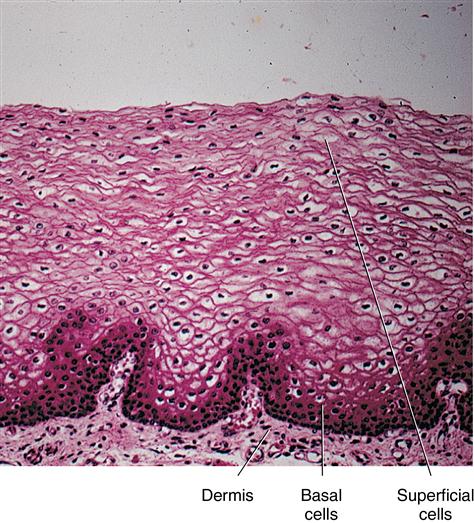
Darker stained cells are basal cells. These are dividing to form more superficial layers. As the cells develop in the basal layer, they gradually migrate to the surface and are then lost by attrition.
The dermis is closely associated and adherent to the epidermis and has an interdigitating relationship with it in some areas. Because epithelium does not contain blood vessels, the skin depends on vessels located in the connective tissue of the dermis. The vessels are in close proximity, nourishing the skin and playing an important part in its function of thermal regulation. Nerves also exist in the dermis, and some penetrate the epithelial layer to function as receptors. Sweat glands, hair follicles and their associated sebaceous glands, and erector pili muscles are located in the dermis and subcutaneous tissue. Ectoderm is the source of the epithelial lining of some internal organs, but not of all epithelial-lined surfaces. For example, the epithelial lining of the alimentary canal is of endodermal origin. The epithelial lining of the peritoneal cavity and the endothelial lining of blood vessels are from mesoderm. Epithelium is described according to cell shape and cell arrangement in one or more layers. Some cells form a single layer known as simple epithelium. Epithelium with all cells in contact with the basal lamina, but not with the surface, is known as pseudostratified. The type consisting of several cell layers with only the basal cell layer in contact with the basal lamina is known as stratified epithelium (Fig. 2-2). Further modifications are based on cell shape. For example, the surface cells may be flattened, as in keratinized stratified squamous epithelium of the palm of the hand (see Fig. 2-2).
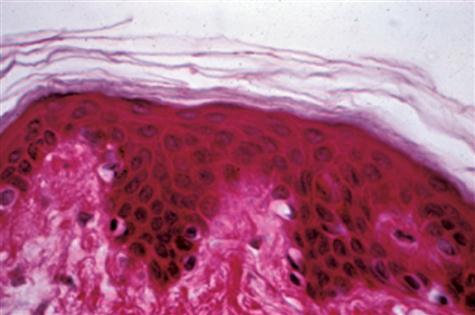
This epithelium is distinctive in that its surface layers are dead and nonnucleated, and cell contents are filled with keratin. This skin is located on the palms of the hands and soles of the feet.
Epithelial membranes function in one or more of the absorptive processes: contractility, digestion, secretion, excretion, protection, and sensation. Table 2-1 illustrates the classification of epithelia by cell type, cell shape, cell modifications, characteristics, and location.
Table 2.1
< ?comst?>
< ?comen?>< ?comst1?>
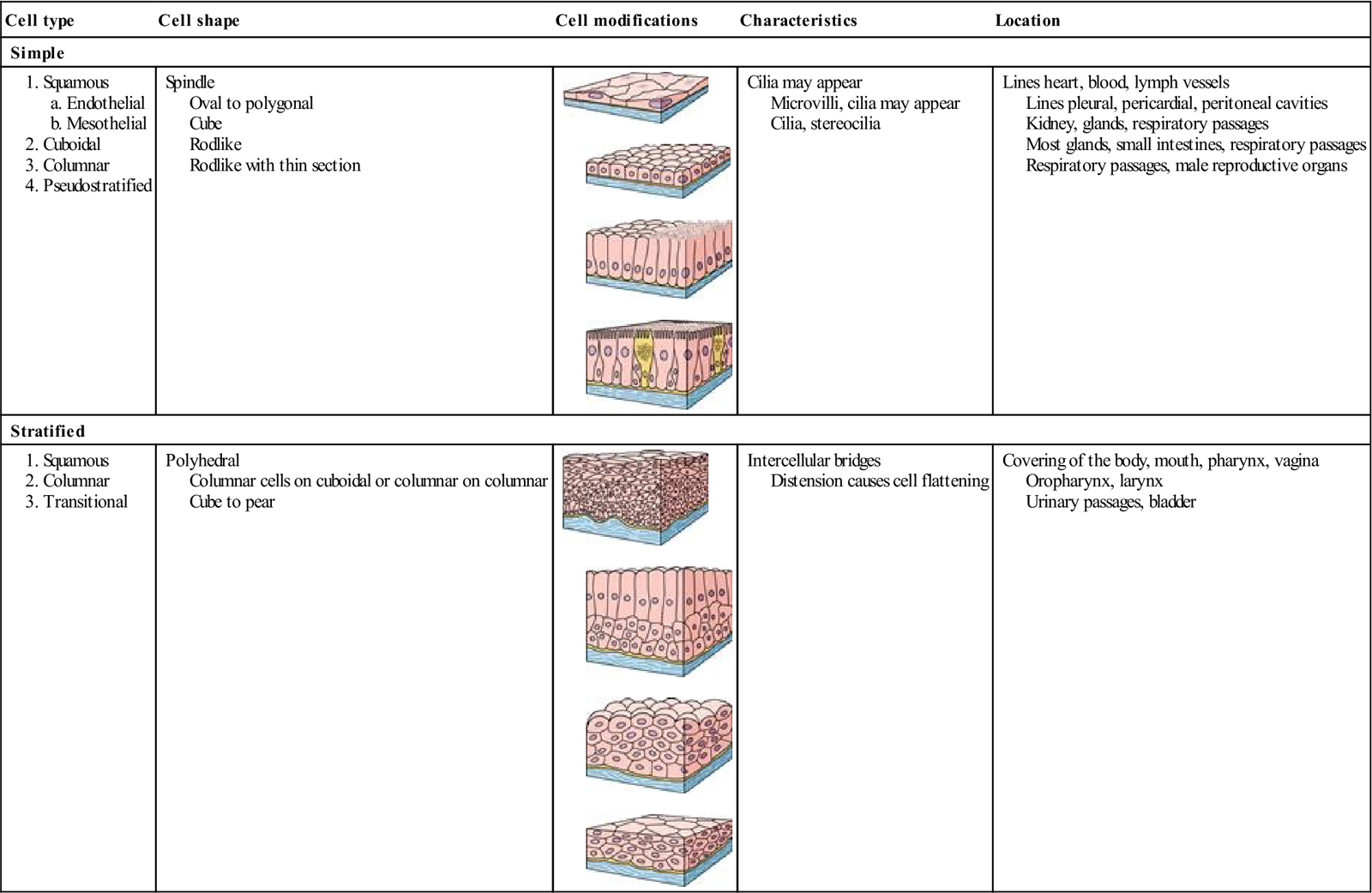
< ?comst1?>
< ?comen1?>
Images from Gartner LP, Hiatt JL: Color textbook of histology, ed 3, St. Louis, 2007, Saunders.
Neural tissue
Neural tissue is a second type of tissue. Nerve tissue arises from neuroepithelial cells, which are highly organized areas for reception and correlation. The nervous system carries out numerous functions with only two principal types of cells, which are the neurons and the neuroglia. Neurons are the nerve cells that receive and conduct impulses and regulate muscle and gland activity. Neuroglial cells are the supporting cells of the nervous system. Each neuron consists of three parts. The first part is the cell body or perikaryon, which contains the nucleus and the cytoplasm. The cytoplasm contains a chromatophilic substance or rough endoplasmic reticulum (RER). The function of the RER, as in other cells, is protein synthesis. Sensory ganglia are accumulations of cell bodies outside the CNS swellings associated with, for example, each of the spinal nerves containing unipolar or pseudounipolar ganglion cells held together with a connective tissue capsule. These ganglia are called dorsal root ganglia of the spinal cord (Fig. 2-3). Some ganglia associated with the cranial nerves include the trigeminal, facial, glossopharyngeal, and hypoglossal cranial nerves (Fig. 2-4).
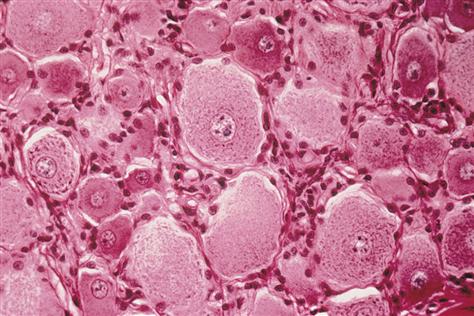
A sensory ganglion of a spinal nerve appears as swelling of a nerve; these are called dorsal root ganglia.
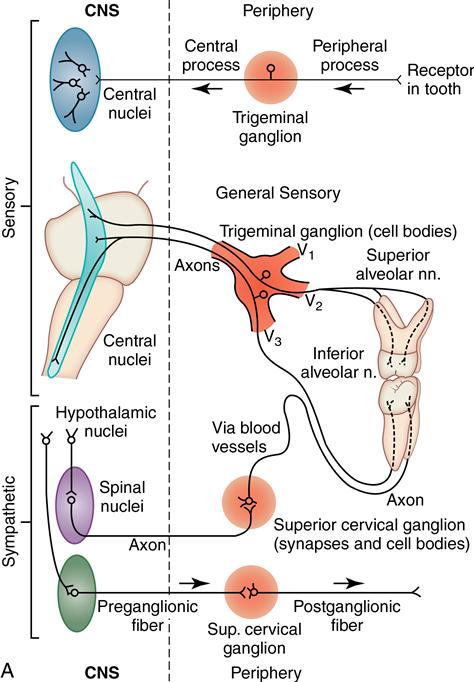

Using the sensory and sympathetic innervation to the head, this figure demonstrates the differences in the two systems and the nomenclature associated with each one. The peripheral nerves and ganglia are located to the right of the dotted line and the nuclei in the central nervous system are located to the left of the dotted line. B, This figure is representative of a typical cross section of a spinal nerve. There are 31 pairs of spinal nerves in the human body: 8 cervical, 12 thoracic, 5 lumbar, 5 sacral, and 1 coccygeal. They emerge through the intervertebral foramen between the vertebrae. The dorsal roots have afferent nerve fibers (Sensory-General Sensory Afferent – GSA) while the ventral roots contain two types of efferent fibers (Sympathetic-General Visceral Efferent-GVE and Somatic Efferent (SE). The sensory fibers of the dorsal root have cell bodies located in the dorsal root ganglia and terminate in a variety of receptors, e.g., Pacinian corpuscles. The ventral root contains SE nerves that innervate various skeletal muscles of the trunk. The preganglionic sympathetic GVE nerves synapse in the sympathetic trunk ganglion with the postganglionic fibers innervating blood vessel smooth muscle as well as other structures containing smooth muscle, e.g., piloerector muscles. (From Beachey W: Respiratory care anatomy and physiology: foundations for clinical practice, ed 2, St. Louis, 2007, Mosby.)
Proteins travel from the perikaryon by axoplasmic transport into the second part of the neuron, the axon, which is a long, thin singular process that varies in length from a few millimeters to several feet or more. The axon conducts nerve impulses away from the nerve cell body. It terminates by branching into axon terminals, or synaptic terminals. Most axons outside the CNS are protected and insulated by a myelin sheath, which is a multilayer of phospholipid produced by the neurilemma (Schwann cells) (Fig. 2-5). The third component of the neuron is the dendrite; usually there are multiple dendrites, which receive impulses and conduct these impulses to the cell body (Fig. 2-6).
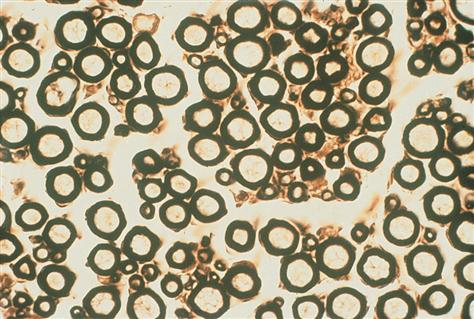
Myelin insulates the nerve axon and is produced by Schwann cells. The axon is a single, thin process capable of transmitting impulses to other neurons. Impulses are received by the dendrites and travel to the cell body and then the axon terminals, where they may contact dendrites of an adjacent nerve cell.
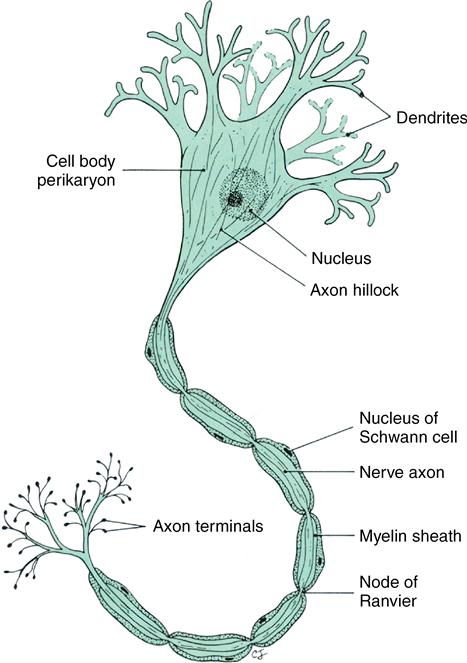
Myelin insulates the axon and is produced by Schwann cells. Impulses received by the dendrites travel to the cell body and then to the axon terminals, where they may contact the dendrites of an adjacent nerve cell.
Neuroglial cells carry out the functions of support. These are 5 to 50 times more numerous than neurons. Neuroglial cells protect and support nerve cells, and some are even phagocytic, meaning that they ingest bacteria.
Connective tissue
Connective tissue varies in its proportion of cells, fibers, and intercellular substance and its location in the body. Connective tissue proper is classified as loose (Fig. 2-7), dense (Fig. 2-8), or loose connective tissue with special properties. It functions in tissue support, and protection of the body parts, in areas of fluid exchange and storage of adipose (fat) tissue. The ligaments that attach bones and the tendons that attach muscles to bones are forms of dense connective tissue.
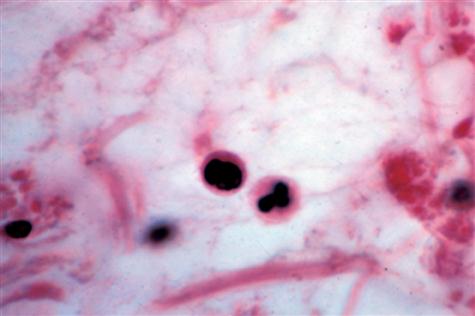
Observe the collagen and elastin fibers and numerous fibroblasts seen in loose connective tissue.
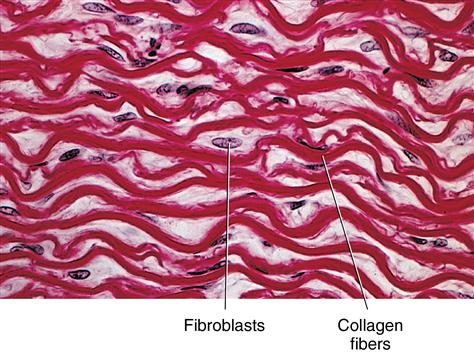
Large bundles of collagen fibers appear in longitudinal section, with a few pale-stained fibroblasts interspersed between them. The faint banding of these collagen fibers cannot be seen at this magnification.
Cartilage
The three types of cartilage are hyaline (Fig. />
Stay updated, free dental videos. Join our Telegram channel

VIDEdental - Online dental courses










